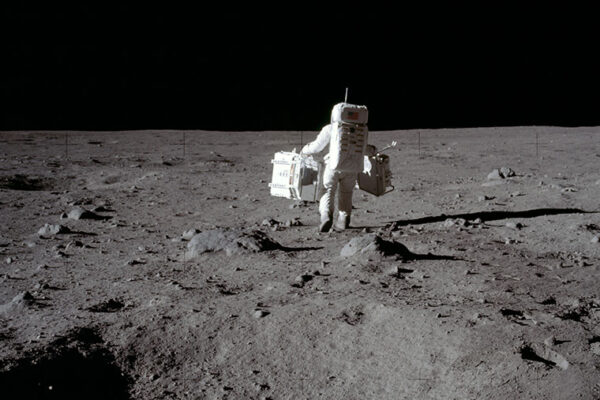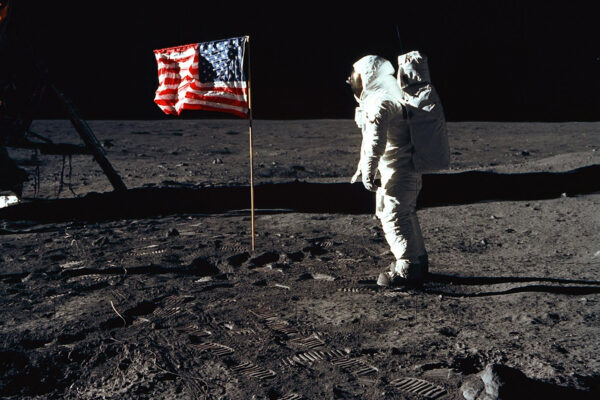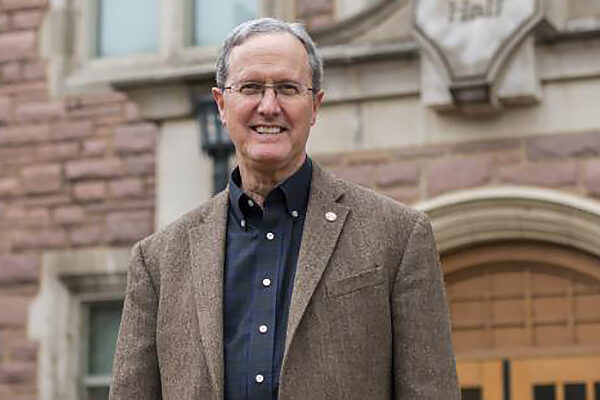(Video by Tom Malkowicz/Washington University)
In the spring of 1969, while visiting the Polar Center at Ohio State University, Ghislaine Crozaz was offered a position on the first all-women science expedition to Antarctica.
“I said ‘No, thank you,’” she wrote in an email from her home in Brussels.
The prior year, Robert M. Walker, then-professor of physics in Arts & Sciences, had offered Crozaz a position as a postdoctoral researcher at Washington University in St. Louis.
“I had come to the United States to participate in the multidisciplinary study of the first lunar samples,” she said. “This was a much more exciting endeavor than Antarctica.”
Crozaz joined Walker’s team, eventually joining the faculty and becoming a part of the McDonnell Center for the Space Sciences, with Walker as its inaugural director.
Apollo 11 launched from the Kennedy Space Center on July 16, 1969. The mission landed on the moon July 20, and returned to Earth July 24. “We watched the lunar landing in July 1969 with awe, like billions of other people on Earth,” Crozaz said. “Only some 10 years after the first human ventured into space, Neil Armstrong and Buzz Aldrin were on the surface of the moon collecting the precious samples that we were going to receive at the beginning of September, after the required quarantine period.”
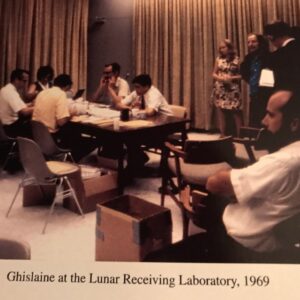
After receiving their allocation, the team worked day and night to study the samples and publish research for the first annual Apollo 11 Lunar Science Conference — now known as the Lunar and Planetary Science Conference (LPSC).
‘What are you still doing with them?’
During the past 50 years, lunar science, bolstered by those first samples, continues to thrive at Washington University. There have been additional missions to the moon, but as new generations of scientists arrive at Washington University, they continue to use those same samples to add to the growing body of knowledge — not just knowledge about the moon, but also the Earth, the solar system and the universe that binds it all together.
In 1998, as a new graduate student, Ryan Zeigler was surprised to find scientists still studying moon rocks from the Apollo missions. “I’m like, ‘Those rocks have been here for 30 years, what are you still doing with them?’”
A new grad student today might ask the same question of Zeigler, 50 years after the Apollo 11 mission brought back the first samples from the moon: What new knowledge could we possibly glean from these old rocks?
But, as Zeigler wrote in an abstract for the 2019 LPSC, lunar samples are “the gift that keep on giving.” He should know. Zeigler earned a PhD in physics from Washington University in 2004, and now works as the lunar sample curator and a planetary scientist at NASA’s Johnson Space Center in Houston.
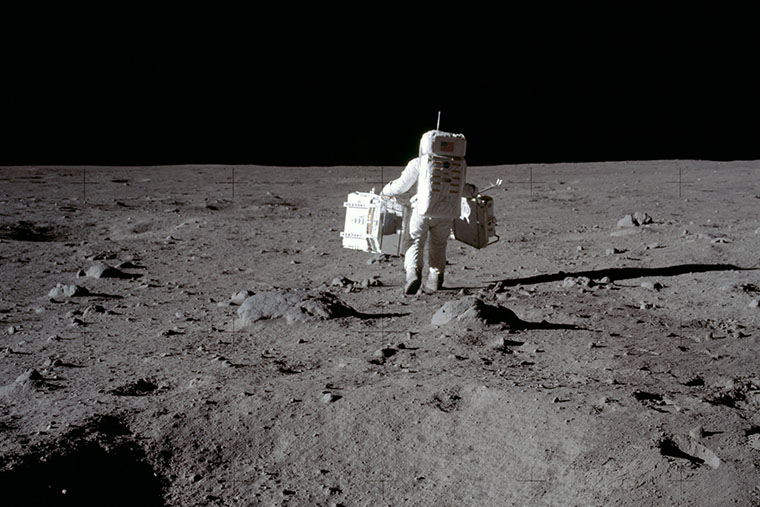
Zeigler was joined at LPSC by Bradley L. Jolliff, the Scott Rudolph Professor of Earth and Planetary Sciences in Arts & Sciences, and Kainen Utt, a physics graduate student.
All three scientists have made the case, directly or through their current research, that the rocks and other samples brought back by Apollo 11 and subsequent missions have fundamentally changed the way scientists understand things such as the formation of the solar system. They also made clear that there are questions — questions asked and questions we don’t yet know we have — that may be answered by studying these samples.
Bits of rock and soil
Apollo 11 returned to Earth from its eight-day mission on July 24, 1969. With it were moon samples of rock and regolith — materials from the surface, including soil.
Thanks to lobbying by Walker, who served on the scientific team that advised NASA on the handling and distribution of samples, Washington University was one of the first 150 universities to obtain bits of rock and soil from Apollo 11. Samples from that mission — and those from almost every Apollo mission until the last one in December 1972 — were securely housed on the fourth floor of the physics department’s Compton Laboratory until the summer of 2018.
“That first sample was ‘Sample 10084,’ ” Jolliff said with a smile. “That is one of the most studied geological samples ever. There have been hundreds of papers written on it.” Including more than a few by Jolliff himself. He also presented an abstract at LPSC on the continued importance of samples.
Studying them can, of course, tell scientists about conditions on the moon, as well as help researchers better understand data from remote sensing to gain a fuller understanding of what it’s like up there now, and how things may have changed.
Jolliff studies lunar samples both up-close and through remote sensing, and the two methods complement each other. “The samples are used as ‘ground truth,’” he said. For instance, if a new instrument comes online, it can be pointed at the spot from which the samples were taken. Since researchers already know what is there, they can use that knowledge to calibrate the instrument.
Pieces of rock and soil can also help scientists look into the moon’s past.
“We used to think of the moon as bone dry,” Jolliff said. But looking at old lunar samples using new equipment can illuminate properties that were there all along. “SIMS (secondary-ion mass spectrometry) is sensitive enough to measure water. Now we know it’s not completely dry,” Jolliff said. New information presents an opportunity to ask new questions, such as the role of water in the moon’s history.
Beyond past and present conditions on the moon however, studying lunar samples also has informed theories on the formation of the solar system.
“We’ve used new technology to better determine the ages of craters,” Jolliff said. “It’s really helping us work out the timing of the heavy bombardment,” referring to a time in the solar system’s history after the planets had formed when they were under “attack” by a constant barrage of asteroid and meteor strikes.
Narrowing the time frame of this event has profound effects on the way scientists understand the formation of the solar system. It can help scientists determine if the giant gas planets formed close to the sun, then drifted outward, gravitationally disturbing the asteroids in the Kuiper belts and sending them crashing into the inner planets. Or did Jupiter form farther from the sun, migrate inward, and then reverse course, settling in its current orbital location?
If we could nail down the age of the heavy bombardment, Jolliff said, “it would really tell us something fundamental about the early solar system.”
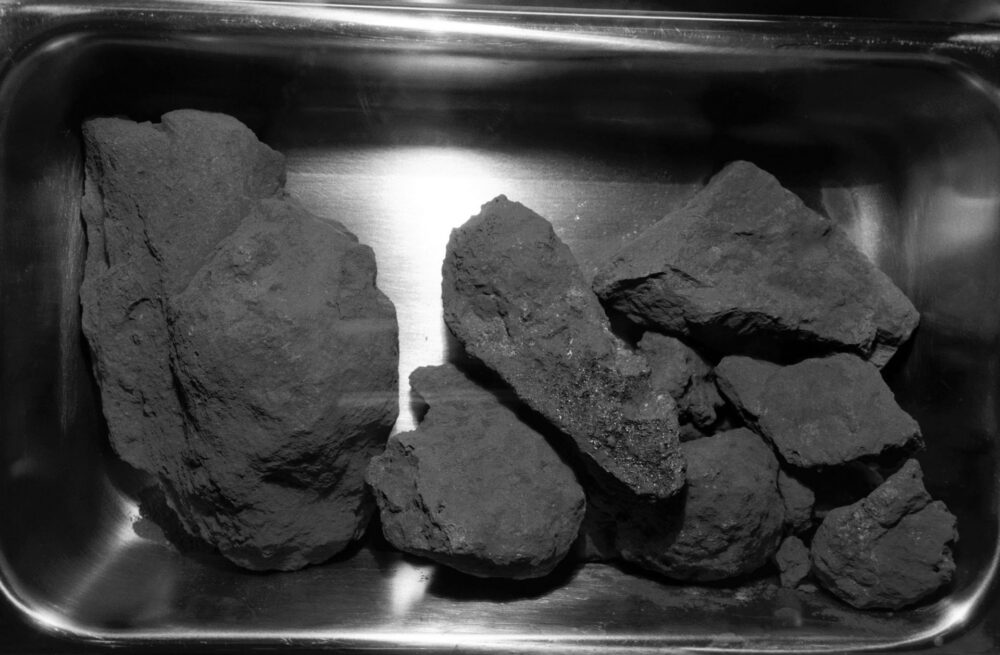
A ‘sliver’ of the research
Jolliff has been studying lunar samples for more than three decades. His work began 20 years after Crozaz turned down a chance to make history in the Arctic and, in turn, made history at Washington University. Crozaz and Bob Walker ultimately married; she retired 15 years ago as a professor emerita of Earth and Planetary Sciences in Arts & Sciences.
Five years after Crozaz’s retirement, Zeigler handled his first moon rock. “It was equal parts exciting and terrifying,” he recalled.
And still, 50 years after the samples were brought to Earth, young researchers study them and continue to make new discoveries. This is in part thanks to new technology.
“When the Apollo 11 samples were brought back, we didn’t have access to spectroscopic techniques with the spatial resolution needed to observe some of the small-scale effects,” Utt said. The size he’s referencing is tiny: 60 nanometers on a single grain of soil.
Utt studies space weathering, or how exposure to space has affected the surface of the moon over hundreds of millions of years, in the lab of Ryan Ogliore, assistant professor of physics. He’ll use this knowledge not only to understand the moon’s history, but he can extrapolate to other “airless bodies,” such as asteroids and, to some degree, planets with little-to-no atmosphere.
Jolliff, Utt and Zeigler represent just a sliver of the spectrum of research that continues to be dependent on lunar samples. Though it waxes and wanes, interest in the moon rocks shows no signs of going away. “It goes up and down,” said Ziegler, who is responsible not only for protecting the Apollo samples, but for handing them out to researchers to study.
“As new instruments and scientists become active, they think of new ideas,” Zeigler said. “And previous ideas inform new ones.”
Still, new moon samples would be great, Zeigler said, but there’s plenty to do at the moment. “We’ve handed out 500 pieces to researchers,” he said. “We are trying to protect them, but we also want to maximize the science.”
